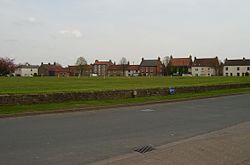Scorton, Yorkshire
| Scorton | |
| Yorkshire North Riding | |
|---|---|
 Scorton Village Green | |
| Location | |
| Grid reference: | NZ249002 |
| Location: | 54°23’49"N, 1°36’42"W |
| Data | |
| Population: | 1,012 (2011, with Uckerby) |
| Post town: | Richmond |
| Postcode: | DL10 |
| Dialling code: | 01748 |
| Local Government | |
| Council: | Richmondshire |
| Parliamentary constituency: |
Richmond (Yorks) |
Scorton is a village in the North Riding of Yorkshire, eight miles north-west of Northallerton. It is part of the ancient Liberty of Richmondshire.
The village is at the northern end of the B6271 from Northallerton where the B1263 from Richmond joins it. Scorton Beck, a tributary of the River Swale, flows south on the east side of the village. The nearest settlements are Bolton-on-Swale half amile to the south, Catterick a mile and a half to the south west and Brompton-on-Swale two miles to the west.
History
The village appears in the Domesday Book as "Scortone" in the lands of Count Alan of Brittany, who was tenant-in-chief during the Norman invasion. Before the invasion the manor was granted to Thorfin of Ravensworth but subsequently granted in 1086 to Bodin, brother of Bardulf.[1]
The manor was thereafter split into two parts, the larger granted to the Fitz Hugh family and the smaller to the Fitz Alans. The descent of the larger part of the manor followed that of the manor of Kirkby Ravensworth until 1512 when it came into the Fiennes family, who were entitled as Baron Dacre. In 1600 the manor was left to Charles Tankard and Christopher Jeynes, who had sold it to Leonard Wastell by 1616. Towards the end of the 18th century the manor passed to the Earl of Tyrconnel and followed that family's descent.[2][3]
The name is derived from a combination of the Old Norse word skor, meaning a rift in the rock, and the Old English suffix tūn, meaning farm or settlement. Put together they mean ravine farm.[4][5]
Scorton was home to the now closed Scorton Grammar School, 1720–1991. Most of the buildings and grounds have been converted into houses. Scorton has a raised village green, one of only two in England.[6] It is said that the green was built in the early 18th century by John Noble, the first headmaster of Scorton Grammar School. There was also a hospital, St John of God, built in 1880 in the grounds of the former convent of St Clare. It is now a nursing home, Abbey Care Village.[2][3]

Between 1939 and 1945 the village was home to RAF Scorton, which served as a satellite of RAF Catterick. Many squadrons flew from Scorton during the Second First World Warncluding No. 56 Squadron RAF who flew Spitfires and others who flew Beaufighters. The aerodrome has now been extensively quarried away.
Scorton was once served by the Eryholme-Richmond branch line but it was closed in 1969. The station building is now a house and much of the line between Scorton railway station and Catterick Bridge has been destroyed by quarrying.[7]
Society and culture

Scorton once had four public houses. The Royal and St Cuthbert's Inn have been closed and converted into houses. The Heifer and the Farmers' Arms survive. There are several small businesses including a village shop incorporating a post office. Education for Years 1-6 is provided at Bolton-on-Swale St Mary's Church of England (VA) Primary School.[8]
The Ancient Scorton Silver Arrow contest is an archery competition founded in the village in 1673, which returns to Scorton only when a resident wins, as last happened in 2008.[9][10][3]
The Scorton Feast is held each year around 15 August each year, which celebrated its 750th anniversary in 2006.
Churches
Scorton Methodist Church, on the village green, was built in 1908
The nearest Church of England church is St Mary's in Bolton-on-Swale.
Outside links
| ("Wikimedia Commons" has material about Scorton, Yorkshire) |
References
- ↑ Scorton, Yorkshire in the Domesday Book
- ↑ 2.0 2.1 A History of the County of York: North Riding - Volume : @ (Victoria County History)[1]
- ↑ 3.0 3.1 3.2 Bulmer's Topography, History and Directory (Private and Commercial) of North Yorkshire 1890. S&N Publishing. 1890. p. 376. ISBN 1-86150-299-0.
- ↑ Watts (2011). Cambridge Dictionary of English Place-names. Cambridge University Press. p. 532. ISBN 978-0521168557.
- ↑ Mills, Anthony David: 'A Dictionary of British Place-Names' (Oxford University Press, 2003) ISBN 978-0-19-852758-9
- ↑ Chrystal, Paul (2017). The Place Names of Yorkshire; Cities, Towns, Villages, Rivers and Dales, some Pubs too, in Praise of Yorkshire Ales (1 ed.). Catrine: Stenlake. p. 71. ISBN 9781840337532.
- ↑ Ludlam, A.J. (1993). The Catterick Camp Military Railway and the Richmond Branch. The Oakwood Press. ISBN 0-85361-438-5.
- ↑ "Scorton businesses". http://www.scorton.com/index.php?option=com_content&task=category§ionid=7&id=32&Itemid=28. Retrieved 31 May 2013.
- ↑ "The Antient Silver Arrow - The Scorton Arrow". The Society of Archers and The Antient Silver Arrow. http://scortonarrow.com/. Retrieved 26 December 2015.
- ↑ "Scorton Arrow". http://scortonarrow.com/Records.htm. Retrieved 26 December 2015.
